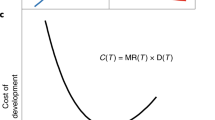Abstract
HUTCHINSON1 noted that congeneric species which diverge in size when sympatric tend to differ in the length of their feeding structures by a factor of about 1.28. He postulated that this average amount of character displacement represented the lower limit to similarity for competing species. It has also been noted that the relative size increase between larval instars of many arthropods (Dyar's constant)2, or between year classes in many salamanders (as reported here), has the same magnitude as Hutchinson's constant. The similarity of this developmental constant to the ecological constant suggests that the degree of divergence between age classes has the same ecological basis as that between competing species. Although many examples of these apparent ecological and developmental constants have been documented, there is yet no mechanism to explain either their relative degree of constancy or their average magnitude3. Here I offer a possible explanation for both.
This is a preview of subscription content, access via your institution
Access options
Subscribe to this journal
Receive 51 print issues and online access
$199.00 per year
only $3.90 per issue
Buy this article
- Purchase on Springer Link
- Instant access to full article PDF
Prices may be subject to local taxes which are calculated during checkout
Similar content being viewed by others
References
Hutchinson, G. E. Am. Nat. 93, 145–159 (1959).
Enders, F. Environ. Ent. 5, 1–10 (1976).
Horn, H. S. & May, R. M. Nature 270, 660–661 (1977).
Simpson, G. G., Roe, A. & Lewontin, R. C. Quantitative Zoology, 2nd edn (Harcourt, Brace and World, New York, 1960).
Selander, R. K. Condor 68, 113–151 (1966).
Schoener, T. W. Evolution 19, 189–213 (1965).
May, R. M. & MacArthur, R. H. Proc. natn. Acad. Sci. U.S.A. 69, 1109–1113 (1972).
Van Valen, L. Evol. Theory 1, 31–49 (1973).
Maiorana, V. C. Can. J. Zool. (in the press).
Van Valen, L. Am. Nat. 99, 377–390 (1965).
Fraser, D. F. Ecology, 57, 238–251 (1976).
Rose, B. R. Ecology, 57, 531–541 (1976).
Roughgarden, J. Am. Nat. 108, 429–443 (1974).
Schoener, T. W. Ecology 49, 704–726 (1968).
Root, R. B. Ecol. Monogr. 37, 317–350 (1967).
Allaire, P. N. & Fisher, C. D. Auk 92, 260–269 (1975).
Lack, D. Darwin's Finches (Cambridge University Press, Cambridge, 1947).
Cranbrook, Lord Proc. zool. Soc., Lond. 128, 597–600 (1957).
Grant, P. R. Evol. Biol. 8, 237–337 (1975).
Grant, P. R. Postilla 90, 1–106 (1965).
Grant, P. R. Syst. Zool. 21, 289–291 (1972).
Huey, R. B., Pianka, E. R., Egan, M. E. & Coons, L. W. Ecology 55, 304–316 (1974).
Schoener, T. W. & Gorman, G. C. Ecology 49, 819–830 (1968).
McEachran, J. D. & Martin, C. O. Environ. Biol. Fish. 2, 121–130 (1977).
Heatwole, H. & Davis, D. M. Ecology 46, 140–150 (1965).
Maly, E. J. & Maly, M. P. Oecologia 17, 325–333 (1974).
Price, P. W. Ecology 53, 190–195 (1972).
Culver, D. C. Ecology, 51, 949–958 (1970).
Walt, J. F. & McPherson, J. E. Ann. ent. Soc. Am. 66, 1103–1107 (1973).
Van Derwerker, G. K. & Kulman, H. M. Ann. ent. Soc. Am. 67, 29–31 (1974).
Hoxie, R. P. & Wellso, S. G. Ann. ent. Soc. Am. 67, 183–186 (1974).
Hatchett, J. H., Daugherty, D. M., Robbins, J. C., Barry, R. M. & Houser, E. C. Ann. ent. Soc. Am. 68, 209–213 (1975).
Nielson, M. W., May, C. J. & Tingly, W. M. Ann. ent. Soc. Am. 68, 401–403 (1975).
Jennings, D. T. Ann. ent. Soc. Am. 68, 597–606 (1975).
Kirkland, R. L. & Goeden, R. D. Ann. ent. Soc. Am. 70, 583–587 (1977).
Reyment, R. & Van Valen, L. Bull. geol. Inst. Univ. Upsala N. S. 1, 83–94 (1969).
Tilley, S. G. Ecology 54, 3–17 (1973).
Houck, L. D. Copeia 1977, 70–83 (1977).
Peacock, R. L. & Nussbaum, R. A. J. Herpetol. 7, 215–224 (1973).
Bruce, R. C. Copeia 1971, 234–246 (1971).
Bruce, R. C. J. Herpetol. 6, 43–51 (1972).
Bruce, R. C. Copeia 1975, 129–137 (1975).
Sayler, A. Copeia 1966, 183–193 (1966).
Highton, R. Copeia 1962, 597–613 (1962).
Author information
Authors and Affiliations
Rights and permissions
About this article
Cite this article
MAIORANA, V. An explanation of ecological and developmental constants. Nature 273, 375–377 (1978). https://doi.org/10.1038/273375a0
Received:
Accepted:
Issue Date:
DOI: https://doi.org/10.1038/273375a0
This article is cited by
Comments
By submitting a comment you agree to abide by our Terms and Community Guidelines. If you find something abusive or that does not comply with our terms or guidelines please flag it as inappropriate.



